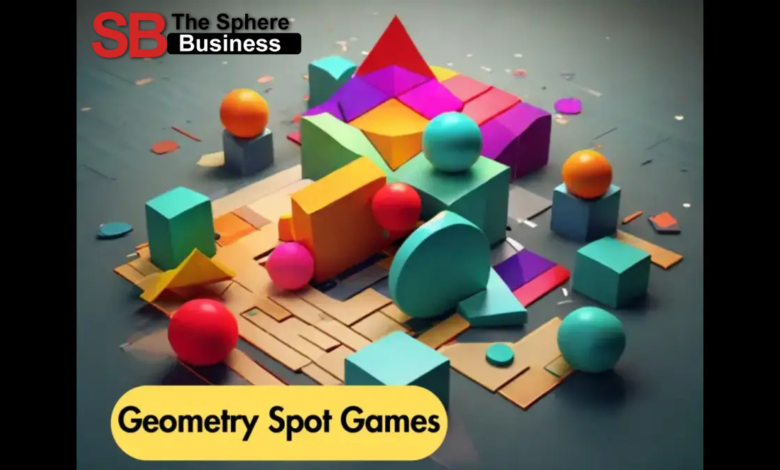Geometry Spot: Understanding Key Concepts and Applications

Geometry, a branch of mathematics that deals with shapes, sizes, and properties of space, has a profound impact on various fields, from engineering and architecture to art and science. The “geometry spot” refers to a focal area or key concept within this domain that allows learners and professionals to explore geometric principles in depth. In this article, we will dive into several aspects of geometry, exploring fundamental topics and their real-world applications.
What is Geometry?
Geometry is the study of shapes, sizes, properties of space, and the relationships between different figures. It originated in ancient Egypt and Mesopotamia, where it was used for land measurement and astronomy. Greek mathematician Euclid formalized geometry, and his work, known as “Euclidean geometry,” laid the foundation for much of modern geometry. The “geometry spot” represents the focal point where these core concepts intersect and expand into diverse fields of application.
Types of Geometry Spot: Euclidean and Non-Euclidean
One of the primary distinctions in geometry is between Euclidean and Non-Euclidean geometries. These two categories of geometry focus on different approaches to space and its dimensions.
- Euclidean Geometry Spot: Based on Euclid’s axioms, this geometry deals with flat, two-dimensional spaces. The basic postulates of Euclidean geometry include points, lines, and planes, with principles such as parallel lines never meeting and the sum of angles in a triangle equaling 180 degrees.
- Non-Euclidean Geometry Spot: This includes both spherical and hyperbolic geometries, which deviate from Euclidean principles. For example, in spherical geometry, parallel lines may intersect, and the sum of angles in a triangle can exceed 180 degrees. This branch is crucial for understanding the geometry of curved spaces, such as on Earth’s surface or in the universe.
Key Concepts in Geometry Spot
Understanding the basics of geometry requires knowledge of several key concepts, which form the foundation for more complex topics.
1. Points, Lines, and Planes
These are the basic elements of geometry. A point represents a location in space, while a line connects two or more points and extends infinitely in both directions. A plane is a flat surface that extends infinitely in all directions. These three components are the starting point for any geometric figure.
2. Angles
An angle is formed when two rays meet at a common endpoint. Angles are measured in degrees, and they come in different types:
- Acute Angles (less than 90°)
- Right Angles (exactly 90°)
- Obtuse Angles (more than 90° but less than 180°)
- Straight Angles (180°)
The study of angles is crucial in both theoretical geometry and practical applications, such as in engineering and construction.
3. Triangles: A Fundamental Geometry Spot
Triangles are among the most basic shapes in geometry. They are three-sided polygons, and their properties are essential to the study of other shapes. Triangles can be categorized into different types based on their angles and sides:
- Equilateral Triangle: All sides and angles are equal.
- Isosceles Triangle: Two sides are equal, and two angles are equal.
- Scalene Triangle: All sides and angles are different.
One of the most critical theorems in geometry related to triangles is the Pythagorean Theorem, which states that in a right-angled triangle, the square of the hypotenuse (the side opposite the right angle) is equal to the sum of the squares of the other two sides.
4. Circles: Exploring the Geometry Spot of Curved Shapes
A circle is a set of points that are all equidistant from a central point. Circles are used extensively in geometry and trigonometry. Key concepts related to circles include:
- Radius: The distance from the center to any point on the circle.
- Diameter: Twice the radius, it stretches across the entire circle, passing through the center.
- Circumference: The distance around the circle, calculated using the formula C=2πrC = 2\pi rC=2πr, where rrr is the radius.
Circles are vital for understanding curved spaces and form the foundation for more advanced geometric figures like ellipses and spheres.
The Importance of Geometry Spot in Real-World Applications
Geometry is not just an academic subject—it plays an essential role in many real-world applications. From the design of buildings to the creation of art, geometric principles shape our world.
1. Architecture and Engineering
One of the most visible applications of geometry is in architecture and engineering. The design of buildings, bridges, and other structures relies heavily on geometric principles. For example, the use of triangles in truss structures ensures stability and strength. Similarly, engineers must consider angles, distances, and forces when designing machines or systems.
2. Computer Graphics and Animation
Geometry spotlights the role of shapes and spaces in digital environments. In computer graphics, geometry is essential for creating realistic 3D models and animations. The use of polygons, meshes, and transformations allows developers to simulate the real world on screen. Geometry is also vital for algorithms that enable 3D rendering and virtual reality experiences.
3. Astronomy and Space Exploration
The understanding of non-Euclidean geometry, especially spherical geometry, is crucial for mapping the cosmos. Astronomers use geometry to calculate distances between stars, planets, and galaxies. Geometry also helps space agencies plan space missions, including the trajectories of spacecraft.
4. Art and Design
Artists have used geometry throughout history to create aesthetically pleasing works. The study of proportions, symmetry, and perspective relies on geometric principles. The golden ratio, a well-known geometric relationship, has been used by artists like Leonardo da Vinci to create harmonious and balanced compositions.
5. Geography and Cartography
Geometry spot also plays a significant role in geography and cartography. Understanding the Earth’s shape as a sphere and mapping its surface using geometric principles allows geographers to create accurate maps. Concepts such as latitude, longitude, and distance are directly tied to geometry.
The Role of Geometry Spot in Problem Solving
Geometry enhances critical thinking and problem-solving skills. By working through geometric problems, individuals develop a logical approach to solving complex issues. Geometry also teaches us how to visualize abstract concepts, an essential skill in many disciplines.
Advanced Topics in Geometry Spot: Topology and Fractal Geometry
As learners advance in their study of geometry, they encounter more complex branches, such as topology and fractal geometry.

- Topology: This area of geometry explores properties of shapes that remain unchanged under continuous deformations, like stretching or bending. Topology is essential in fields such as physics and computer science.
- Fractal Geometry: This is the study of shapes that exhibit self-similarity, meaning they look the same at different scales. Fractal geometry is used to model natural phenomena like coastlines, mountains, and clouds.
Conclusion
The “geometry spot” represents a critical area of study that spans various topics, from basic shapes and angles to advanced fields like topology and fractal geometry. Understanding geometry not only provides insight into the spatial relationships in our world but also equips individuals with essential problem-solving skills. Geometry is everywhere—in the design of buildings, the creation of art, the exploration of space, and even in the technology we use every day. By grasping its core concepts, we can unlock new ways to understand and interact with the world around us.





